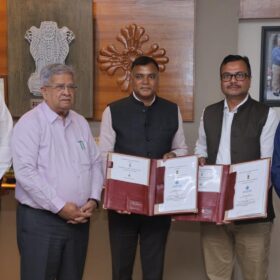From pv magazine Global
Chinese solar module manufacturer Longi has developed a heterojunction back contact (BC) solar cell using a laser-enhanced contact optimization process that reportedly has a total effective processing time of about one-third compared to that of mainstream technologies such as PERC and TOPCon.
The design of the device was presented in the scientific paper “Silicon heterojunction back-contact solar cells by laser patterning,” which was recently published in nature. “This cell can be used in all silicon-based PV application scenarios,” Chaowei Xue, Department Director at Longi Solar, told pv magazine, noting that the device is based on dense passivating contacts containing less hydrogen compared to common contacts used in BC cells, which he said reduces parasitic light absorption and improves passivation.
The company’s researchers explained that laser patterning is currently the cheapest technique for building BC cells and stressed that this process, however, has so far produced devices with efficiency not exceeding 22.5%. Moreover, this technique can lead to laser-beam-induced damage in the cells and lower open-circuit voltage and fill factor, as it causes degradation in the amorphous passivating contact or the crystalline silicon interface.
To address this issue, they used the three laser-patterning steps known as P1, P2 and P3 to create the interdigitated n/p polarity by selectively removing N-contact, P-contact and indium tin oxide (ITO) layers, respectively. The P1 and P3 steps are aimed at isolating the back contact layers of neighboring cells and the P2 step creates an electrical path between the back contact of a cell with the front contact of an adjacent cell. The P3 step, in particular, is often a source of undesired effects such as back contact delamination, flaking, or poor electrical isolation, due to residues that remain in the trench.
“The top-hat-shaped laser beam was operated in two modes,” the research group explained. “Overlap mode, used in P1 and P3, completely removed a layer, whereas the single-shot mode used in P2 preserved the region between consecutive shots. The single-shot mode created partial, instead of full-area, contact between the amorphous silicon hydrogenated film and the ITO layer.”
The research team built the 243.0 cm2 cell with an M6 phosphorus-doped n-type Czochralski monocrystalline silicon wafer. It deposited the dense passivating contacts via plasma-enhanced chemical vapor deposition (PECVD) at 240 C. A pulsed green picosecond laser with a spot of 250 μm was used to ablate the films.
Tested under standard illumination conditions, the champion cell designed by the team achieved a power conversion efficiency of 27.3%.
Furthermore, the academics produced a device with less indium content that achieved an efficiency of 26.5%. “We also demonstrated 26.2% efficiency for HBC solar cells metallized by screen-printed low-temperature copper (Cu) paste,” they said, adding that the proposed manufacturing technique is intended to decouple the use of rare indium and precious silver from the cell’s heterojunction technology, with PERC and TOPCon having scalability limitations because they rely on silver contacts.
Longi has not specified if these results were confirmed by an independent third-party entity.
This content is protected by copyright and may not be reused. If you want to cooperate with us and would like to reuse some of our content, please contact: editors@pv-magazine.com.









By submitting this form you agree to pv magazine using your data for the purposes of publishing your comment.
Your personal data will only be disclosed or otherwise transmitted to third parties for the purposes of spam filtering or if this is necessary for technical maintenance of the website. Any other transfer to third parties will not take place unless this is justified on the basis of applicable data protection regulations or if pv magazine is legally obliged to do so.
You may revoke this consent at any time with effect for the future, in which case your personal data will be deleted immediately. Otherwise, your data will be deleted if pv magazine has processed your request or the purpose of data storage is fulfilled.
Further information on data privacy can be found in our Data Protection Policy.